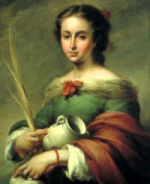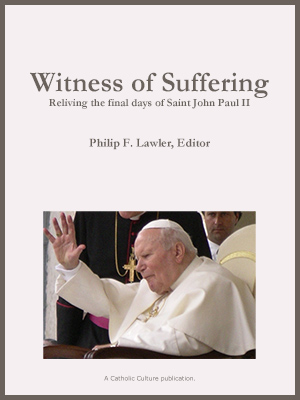The Mass in Need of Artists—Great and Small
By Fr. Jerry Pokorsky ( bio - articles - email ) | Jun 12, 2023
The Gospels are like a photo album. Departing from conventions, the evangelists wrote the biography of Jesus in stand-alone paragraphs (pericopes), roughly arranged in the sequence of His life. Awaiting artistic skills, we might use this outline to frame a picture book to help us follow the life of Jesus in the Mass.
The Liturgy of the Word and the Liturgy of the Eucharist: The Liturgy of the Word fulfills and replaces the worship of the synagogue and teaches the Catholic faith. The Liturgy of the Eucharist fulfills and replaces the sacrificial worship of the Temple with the single Sacrifice of Jesus (cf. Joseph Ratzinger, Spirit of the Liturgy).
The Drama of Direction: Although the direction of worship is sometimes lost, we should recall its significance. During the Liturgy of the Word, the priest, representing God to the faithful, proclaims and explains God’s Word. The Responsorial Psalm is our response. During the Liturgy of the Eucharist, the priest represents the people to God (and faces the Lord). Finally, again representing God (now the Bridegroom), the priest turns again to the people during Communion, now the Bride of Christ.
Images: Synagogue and Temple; high altars of great cathedrals.
The Sign of the Cross: We begin by signing ourselves with the Cross: Father, Son, and Holy Spirit.
The Blessed Trinity—the first mystery of our faith—exists in eternity, before history, and summarizes Revelation from start to finish. God is Creator. The Old Testament hints of God as Three-in-One: “Send forth your Spirit and they shall be created, and you shall renew the face of the earth.” (Ps. 104:30) The evangelists reveal the lineage, birth, and life of Jesus. Jesus promises an Advocate, and the Holy Spirit descends upon Mary and the disciples on Pentecost.
Images: Blessed Trinity; Father, Son, and Holy Spirit.
The Penitential Rite: An expression of sorrow for our sins immediately follows the Sign of the Cross. The Confiteor reminds us of our violations of the Ten Commandments and how we sinned. We beg for the intercession of Mary, the saints, and our neighbors. As we receive the absolution, we renew our love of Jesus: “If you love me, you will keep my commandments.” (Jn. 14:15)
Images: Moses on Mount Sinai; the Prodigal Son.
The Gloria: After receiving the forgiveness of sins (the Penitential Rite forgives all venial sins), we respond with the joyful hymn of the angels at Bethlehem. “Glory to God in the highest.” We imagine the Manger scene in Bethlehem, Mother and Child—with Joseph and the shepherds and wise men. In the field, we hear the heavenly hymn of the angels with its striking beauty that we can only imagine.
Images: The Annunciation; Visitation; Manger scene; the choir of angels among the shepherds.
The Liturgy of the Word: The Old Testament’s first reading and Responsorial Psalm foreshadow the life of Jesus. “In many and various ways God spoke of old to our fathers by the prophets; but in these last days he has spoken to us by a Son.” (Heb. 1:1) The Gospels validate the teachings of the Old Testament with the repeated phrase—especially from the mouth of Jesus during His Passion—“so that Scriptures may be fulfilled.”
The second reading provides lessons from the life and ministry of Jesus in the light of the Resurrection. The Gospel brings us into the heart of the life of Jesus (we dutifully stand, respecting His voice). The homily explains His words, and we respond with the proclamation of our belief as we recite the Creed. Emboldened, we continue our requests for Divine favor in the Prayers of the Faithful.
Images: Jesus preaching in the synagogue; the Sermon on the Mount.
The Liturgy of the Eucharist
The Presentation of the Gifts: The priest prepares for the sacrificial feast with bread and wine, “fruit of the earth/vine and work of human hands,” in memory of Mary’s presentation of Jesus in the Temple. Anticipating the Consecration, we have the dignity to participate in the multiplication of the loaves with our generosity.
Images: The Presentation; the multiplication of the loaves.
The Holy, Holy, Holy: The Sanctus integrates the prayer of the angels in God’s presence in the Book of the Prophet Isaiah with the crowds joyfully cheering Jesus as He enters Jerusalem in preparation for His Passion. As we enter more deeply into the Liturgy of the Eucharist, we accompany Jesus to Calvary in the Canon of the Mass.
Image: Jesus entering Jerusalem.
The Canon and Words of Consecration: The most solemn prayer of the Mass is the Roman Canon, prayed in union with the angels and saints. The Consecration of our gifts—the bread apart from the wine—re-enact the Crucifixion when His blood flowed from His sacred body. The unbloody re-presentation of the Cross anticipates the glorious Resurrection and Holy Communion. Jesus becomes truly present on the altar (Transubstantiation), and we mystically join Him at the foot of the Cross with Mary, Saint John, and the holy women.
Image: The Crucifixion.
The Per Ipsum and the Our Father: The Canon concludes with the doxology, “Through Him, with Him, and in Him.” We give glory to the Presence of Jesus on the altar and receive the Holy Spirit—another Pentecost. As we enter more deeply into His Mystical Body, Jesus gives us the courage to approach the Father not “through” Him, but “in” Him: “Taught our Savior’s command and formed by divine teaching, we dare to say. Our Father…”
Images: The Descent of the Holy Spirit; the Mystical Body of Christ.
Preliminaries to Communion: The priest silently drops a small piece of the Host into the Precious Blood, a reunion reminiscent of the Resurrection. We recall the words of John the Baptist: “Behold, the Lamb of God who takes away the sins of the world.” As we gaze upon the Lamb, we echo the words of the righteous centurion asking the Lord to heal his servant: “O Lord, I am not worthy that you should come under my roof, but say just the word….”
Images: John the Baptist; the centurion; the Resurrection.
Holy Communion: We approach the “table of the Lord” to receive Holy Communion, where the Divine Bridegroom gives Himself entirely to His Bride. Mystically entering the Last Supper, we gaze on the Host and reverently respond with the one-word acknowledgment of our belief in Jesus with “Amen,” and receive Him in Communion, Heart to heart.
Images: The Sacred Heart of Jesus; the Last Supper.
The Communion Prayer and Final Blessing: The Mass concludes with the post-Communion prayer and final blessing. The prayer summarizes our gratitude for His love, and the Church sends us forth with words that paraphrase the departing words of Jesus: “Go therefore and make disciples of all nations, baptizing them in the name of the Father and of the Son and of the Holy Spirit, teaching them to observe all that I have commanded you.” (Mt. 28:19-20)
Images: The Mystical Body of Christ; Isaac Jogues.
Closing Remarks: Like the stained glass in great cathedrals, sacred images help tell the story of the Gospel and the Mass through the work of great artists—or the scribbles of an aspiring Michelangelo or Rembrandt, young or old.
All comments are moderated. To lighten our editing burden, only current donors are allowed to Sound Off. If you are a current donor, log in to see the comment form; otherwise please support our work, and Sound Off!
-
Posted by: Randal Mandock -
Jun. 17, 2023 10:18 AM ET USA
"...so that Scriptures may be fulfilled". About three decades ago when I was a budding apologist for the faith, I used to like to reference that phrase as evidence of Jesus as the Jewish Messiah. It was pointed out to me, perhaps by a priest or fellow apologist, that the interpretation of this phrase by many is backwards. Jesus did not come among us "so that Scriptures may be fulfilled"; the Scriptures were fulfilled because He came as the prophesied Alpha and Omega, far exceeding the prophecies








